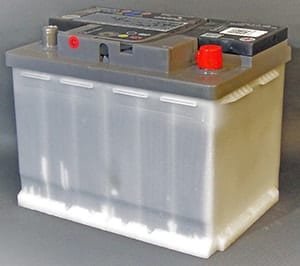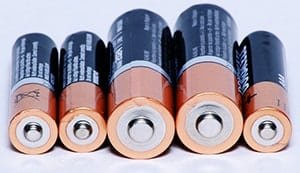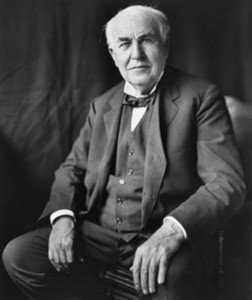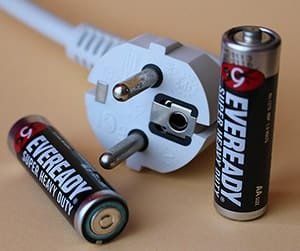Have you ever caught yourself looking at your flashlight wondering how it actually came to be? If you have, don’t worry, you are not alone, flashlight enthusiasts all over, have often asked themselves the same thing. For you, it might seem like flashlights have always been around, but in reality, they weren’t invented until the late 1800s where they got their start as a bicycle light or portable lamp. Keep reading to find out when, where, and how flashlights were invented.
The Pieces That History Needed to Make A Flashlight
The first flashlights used a zinc-carbon battery and carbon-filament bulbs. The batteries and bulbs weren’t very efficient and required periods of “rest” to keep working. This “rest” resulted in the lights flashing hence the name flashlights.
The use of crude dry cells and carbon filament bulbs resulted in high manufacturing costs and very little interest. In 1904, manufacturers began using better dry cell batteries and a tungsten-filament lamp. These improvements lowered manufacturing costs and increased the usefulness and popularity.
Early History of Batteries

In 1866, French scientist Georges Leclanche patented the first wet cell battery. Called wet cells, these batteries contained a liquid electrolyte inside the battery casing. The Leclanche cell wrapped a porous material around a manganese dioxide and zinc anode-cathode. The entire thing was then dipped into an ammonium chloride solution. Wet cell batteries provided up to 1.4 volts for use in things like signaling and telegraphy.
Wet Cells
Wet cells due to their liquid are not for use in portable devices, such as flashlights. This is where the dry cell battery comes into play.
Dry cell batteries use a paste electrolyte rather than a liquid. The dry cell batteries do contain a small amount of liquid though otherwise, the current would be unable to flow.
Dry cells can be turned upside down without fear of breaking or spilling making them the perfect choice for portable devices.
Dry Cells

The first dry cell battery was a zinc-carbon battery that could produce up to 1.5 volts.
The German patent for the first dry cell battery was filed by Carl Gassner in 1886. Gassner modeled the dry cell battery after the Leclanche cell. Dry cells mix ammonium chloride with plaster of Paris to form a paste.
Wet cells use the ammonium chloride as a liquid solution. The U.S. patent for the dry cell was issued in 1887.
“D” Cells
1896 brought about a change in dry cell batteries with the introduction of the “D” cell battery. These batteries were 2.25 inches long and 1.25 inches in diameter. The “D” cell battery was a direct replacement for the #6 battery.
With the “D” cell battery you use several together to generate the same amount of power as the #6 batteries, but you enjoy the smaller size. The benefit to the smaller size was the “D” cell batteries made the portable light a real possibility.
Early History of Incandescent Light Bulbs

It comes into question who actually invented the incandescent lamps. Many people think it was Thomas Edison and Joseph Swan. Historians actually have a list of 22 inventors before them.
No matter who actually invented the incandescent bulb, Edison’s bulb was the best. Edison’s version of the incandescent bulb was superior to others for three reasons. He used a higher vacuum, a higher resistance, and an effective incandescent material.
Incandescent bulbs contain a tungsten filament inside a glass bulb. Producing visible light requires using an electric current to heat the filament. Once a high enough temperature is reached the filament begins to glow. It is protected from oxidation as the glass bulb is filled with an inert gas. Edison’s incandescent light uses a carbon filament connected to platina contact wires.
Tungsten filament lamps weren’t introduced until 1904. These lamps not only lasted longer than carbon filament, they were brighter too. Tungsten lamps filled glass bulbs with an inert gas rather than using a vacuum operation. The inert gas allowed for higher temperatures and better efficiency.
The Invention of the Flashlight and the American Electrical Novelty and Manufacturing Company
Who was David Misell?
David Misell was a British inventor who lived and worked in New York City. David Misell applied for several patents for various electrical gadgets. Despite receiving the grants, not all the gadgets were successful.
In 1896, David Misell worked for Dr. Ted Birdsall on the Portable Electric Lamp. This idea didn’t have much commercial success, but it opened the way for Misell’s Signal Light.
The Signal Light patent became a bicycle light patent after Misell noticed how successful the Acme Bicycle Light was. Misell’s version of the bicycle light used three batteries and encased inside a wood case
In 1897, Dr. Birdsall died unexpectedly; Misell took over the shop and inventory. Misell was an inventor, not a businessman; he needed somebody to finance the operation. This is where Conrad Hubert comes in.
In 1897, Hubert was selling Electric Necktie Pins at his novelty shop when Misell’s bicycle light caught his attention. Hubert ended up buying Misell’s entire operation. This included the rights to the first tubular light that Misell was working on with his assistant, Gustave F. Hitzelberger.
First Tubular Light
The first tubular light used three cell batteries that were .75 inches shorter than the batteries used in the Acme Electric Lamp.
The shorter batteries allowed for the tubular light to be small enough to carry around in a shirt pocket. Upon completion, Misell applied for and obtained US Patent 617,592. On January 10th, 1899 Misell obtained the patent for the tubular flashlight.
The first tubular light required three cells, lens, and a reflector. The outside of the light was a fiber tube with brass end caps. The patent was assigned to Huber in the name of his business “American Electrical Novelty and Manufacturing Company.”
Hubert created the company as a way to sell new battery powered devices.
Hubert knew the flashlight was going to be a success. He focused all his energy on promoting his new light. To bring attention to the flashlight Hubert, donated them to various New York City police precincts. The response from the policemen was quite favorable. These testimonials were then used in to help promote sales.
Hubert knew what he was doing and soon the public wanted to own a flashlight. Hubert also featured the flashlight at the Electrical Show in Madison Square Garden, where it was a huge success.
Beginnings of Ever Ready

Upon the success of the flashlight, the company began mass producing the flashlights. In the beginning, the end caps of these lights was blank. It wasn’t until 1902 that the Eveready trademark was used on each light. During 1902, higher quality filaments were also used in their incandescent bulbs. The better filaments improved the efficiency and run time of the flashlights. The better filament was also cheaper, which brought down manufacturing costs.
American Electrical Novelty and Manufacturing Company soon reorganized. In 1910, they became American Eveready Company and introduced an Eveready tungsten filament bulb.
These advancements garnered them the top name in flashlights. In 1922, with 10 million flashlight users several new styles of flashlights were introduced. Each of the lights was as popular as the next.
Flashlight History Final Thoughts
Thank you for visiting besttacticalflashlights.net. I hope that you found this informative article useful. As a flashlight enthusiast, it is my goal to help others learn as much as they can about flashlights, including their history.
This article wasn’t written to help you purchase a light, it was written to help you learn about how useful flashlights have always been.
In the 1800s flashlights were a necessity because people needed a safer alternative for searching dark closets or rooms. The first tubular flashlight might have been a primitive design, but it was a solid one that flashlights are still modeled after today.
If you are looking to buy a flashlight check out our huge library of flashlight buyer’s guides, you will probably find what you are looking for.
